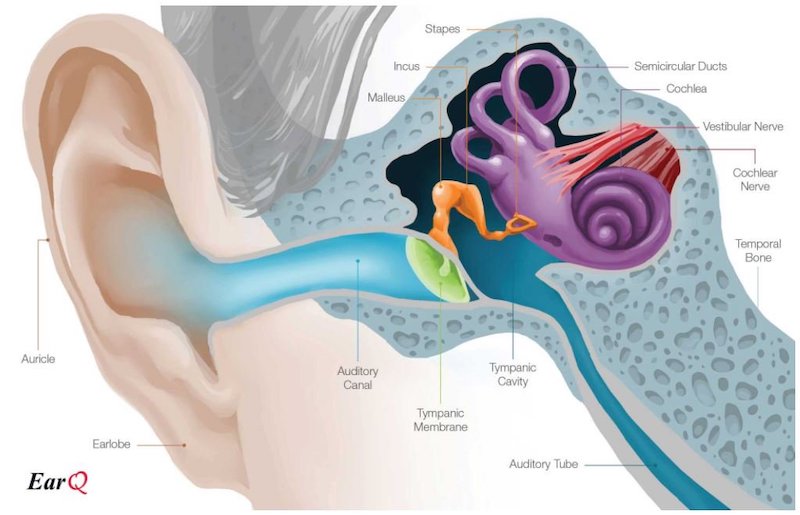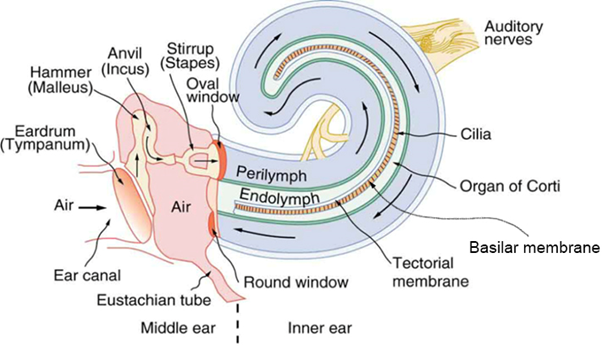How Do We Hear, Smell, and Taste?
Episode #7 of the course Understanding your brain by Betsy Herbert
Welcome back!
Yesterday, we took a glimpse into the amazing complexities of the visual system. Hopefully, you’re thirsting for more! Today, we’ll take a whirl through the rest of the senses, learning how we hear, smell, and taste.
Auditory System
Have you ever pondered how we hear? When you start to think about it, realizing that sound is simply vibrations of air, it’s really quite amazing that we can parse this cacophony of vibrations into distinct sounds that carry meaning—for example, a conversation with a friend in a café, the trill of birdsong in a wood, or a Bach sonata. So, how does our brain do it?

Outer, middle, and inner ear structure.
The outside part of our ear, known as the auricle, is carefully shaped to capture sound and funnel it down the auditory canal, where it hits the eardrum, or tympanic membrane. Like a real drum, this vibrates as the sound hits it, causing three little bones called the malleus, incus, and stapes to vibrate and hit another membrane called the oval window. This pushes fluid back and forth in a little snail-like tube called the cochlea.
But what’s inside this little snail? The diagram below shows a cross-section. As the fluid is pushed back and forth by the vibrating oval window, the orange basilar membrane flexes and vibrates too—a bit like when you hit a ruler against a desk. The cells embedded in this membrane are called hair cells, and they’re precisely that: hairy! They have little “hairs” called stereocilia that wave about in this vibrating fluid. And it’s the bending of these stereocilia, as the fluid is vibrating and as the membrane is oscillating, that causes these cells to fire and send signals down the auditory nerve to the auditory cortex of the brain. Phew!

Cochlea.
After that, just like in the visual cortex, a wealth of further processing happens in the auditory cortex to allow you to interpret the sounds you’re receiving—for example, it uses the small time differences in sound arriving at each ear to localize the sound in 3D space. It can also selectively increase the volume on sounds you want to focus on, like when you’re in a rowdy pub trying to concentrate on what your friend is saying!
Olfactory and Gustatory System
Your sense of smell and taste are a bit simpler; they just rely on the physical binding of molecules to receptors.
For smell, receptors in olfactory sensory neurons in the olfactory epithelium inside your nose respond to small molecules called odorants and send signals to your olfactory cortex. A distinct smell is called an odor and is made up of hundreds of different odorant molecules. Coffee, for example, is made up of about 800 different component odorants! Your olfactory cortex performs clever processing called pattern completion and separation, which allows you to categorize combinations of odorants into distinct categories. This means you’ll still perceive “coffee” by itself, even if its component odorants are intermingling with odorants from the cleaning spray on the table or the body odor of the person next to you!
For taste, it’s a similar process. Molecules bind to taste receptor cells in taste buds on your tongue and trigger signals to be sent to the gustatory cortex. Have you heard of the “taste map”? This was a popular theory that said that different parts of the tongue are responsible for detecting different taste categories, like sweet, salty, sour, bitter. and umami. It turns out it isn’t entirely correct, but it is true that different taste receptor cells respond to different categories of molecules. Certain cells respond to other properties of taste too—for example, spiciness, coolness (think minty toothpaste), or dryness (think wine or tea full of tannins). It’s this selective response of many neurons in combination that allows the brain to build up a “profile” of each food we eat and to instantly recognize it when we do.
That concludes our tour of the senses! Tomorrow, we’ll be considering the opposite direction of information flow. How does our brain send signals out to our body to guide our movements?
See you for that tomorrow!
Betsy
Recommended videos
Hearing and Balance: Crash Course
Share with friends

